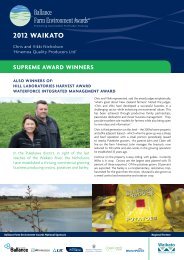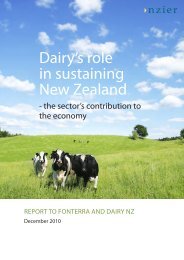NZIER report on compensation for transmission infrastructure
NZIER report on compensation for transmission infrastructure
NZIER report on compensation for transmission infrastructure
You also want an ePaper? Increase the reach of your titles
YUMPU automatically turns print PDFs into web optimized ePapers that Google loves.
Figure 1 Infrastructure surplus<br />
$<br />
Source: <str<strong>on</strong>g>NZIER</str<strong>on</strong>g><br />
Net surplus<br />
from easements<br />
Cost of alternative<br />
borne by Transpower<br />
Net easement costs<br />
borne by landowners<br />
Net loss from<br />
easements<br />
Land use<br />
As illustrated in Figure 1 the cost of the next most efficient alternative <strong>for</strong> transmitting<br />
electricity is assumed to be c<strong>on</strong>stant (the line is flat) and borne by Transpower. An<br />
alternative to building easements over dairy farmland could, <strong>for</strong> example, be running<br />
lines l<strong>on</strong>ger distances over less productive land (also possibly requiring easements).<br />
Transpower would have to fund the additi<strong>on</strong>al cost of running lines over the l<strong>on</strong>ger<br />
route. The cost savings between the two routes is thus the maximum price that<br />
Transpower would be willing to pay <strong>for</strong> the easement.<br />
The relative preference <strong>for</strong> easements or alternatives varies with circumstances and<br />
over time. In the past, <strong>for</strong> instance, transmissi<strong>on</strong> lines have comm<strong>on</strong>ly been run<br />
across Crown land or al<strong>on</strong>g public road corridors, even where this is not the most<br />
direct route, as this reduced the transacti<strong>on</strong> costs of dealing with multiple owners.<br />
When new lines are required and such opti<strong>on</strong>s are less readily available, opti<strong>on</strong>s with<br />
easements become more attractive. And if an opti<strong>on</strong> with easements would achieve<br />
big savings over the next best alternative, it would be in Transpower‟s interest to pay<br />
more to secure the access, in effect sharing with the landowner some of the surplus<br />
that the route would provide.<br />
In several countries landowners are given compensati<strong>on</strong> greater than the estimated<br />
value of the easement. In Québec, <strong>for</strong> example, the total easement area is<br />
compensated <strong>for</strong> at market value of land, in effect providing payment c<strong>on</strong>siderably<br />
greater than estimated costs (see secti<strong>on</strong> 3.4.1). Easements in New Zealand,<br />
however, are compensated <strong>for</strong> at cost. There is some c<strong>on</strong>cern that, at times, these<br />
costs may be understated. If this is the case it is possible that easements would be<br />
c<strong>on</strong>structed when they are not the most efficient opti<strong>on</strong> <strong>for</strong> transmitting electricity.<br />
<str<strong>on</strong>g>NZIER</str<strong>on</strong>g> – Compensati<strong>on</strong> <strong>for</strong> transmissi<strong>on</strong> <strong>infrastructure</strong> 12
















